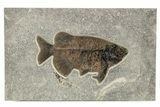This Specimen has been sold.
13" Gorgeous Fish Fossil (Phareodus) - Wyoming
This is a beautifully preserved, 13" long fossil fish (Phareodus encaustus) from the Green River Formation of Wyoming. We collected it this past summer from the "bottom cap" of the 18 inch layer at the Lindgren Quarry near Kemmerer, Wyoming. This layer has the best preservation in the quarry but the stone is much harder to collect and takes 2-3x as long to prepare. The results are stunning though.
This stunning fish is nicely centered on a 21.7 x 13.4" slab of shale. The rock has been backed for stability and to make it easy to install wall mounting hardware.
This stunning fish is nicely centered on a 21.7 x 13.4" slab of shale. The rock has been backed for stability and to make it easy to install wall mounting hardware.
About Phareodus
Phareodus is a genus of predatory freshwater fish found in the famous Fossil Lake deposits of the Green River Formation in Wyoming. It had a mouthful of sharp pointy teeth, making it a voracious lake predator. In fact, the name Phareodus actually means "to have teeth". Spines from other fish such as Mioplosus and Priscacara have frequently been found preserved in their stomachs.
Phareodus is a genus of predatory freshwater fish found in the famous Fossil Lake deposits of the Green River Formation in Wyoming. It had a mouthful of sharp pointy teeth, making it a voracious lake predator. In fact, the name Phareodus actually means "to have teeth". Spines from other fish such as Mioplosus and Priscacara have frequently been found preserved in their stomachs.
SPECIES
Phareodus encaustus
LOCATION
Lindgren Quarry, Kemmerer, Wyoming
FORMATION
Green River Formation - 18 Inch Bottom Cap
SIZE
13" long on 21.7 x 13.4" rock
CATEGORY
SUB CATEGORY
ITEM
#269737
We guarantee the authenticity of all of our specimens.
 Reviews
Reviews











